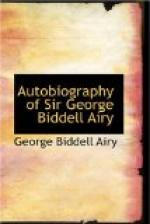I was assured by the officers residing on the Digue that the sea which on breaking is thrown vertically upwards and then falls down upon the pavement does sometimes push the stones about which are lying there and which weigh three or four tons.
I saw some preparations for the foundations of the fort at the eastern extremity of the Digue. One artificial stone of concrete measured 12’9” x 6’7” x 5’7”, and was estimated to weigh 25000 kilogrammes.
CHAPTER VI.
AT GREENWICH OBSERVATORY—1846 TO 1856.
1846
“On Nov. 7th I proposed a change in the form of Estimates for the Observatory. The original astronomical part was provided by the Admiralty, and the new magnetical and meteorological part was provided by the Treasury: and the whole Estimates and Accounts of the Observatory never appeared in one public paper. I proposed that the whole should be placed on the Navy Estimates, but the Admiralty refused. I repeated this in subsequent years, with no success. Meantime I always sent to the Admiralty a duplicate of my Treasury Estimate with the proper Admiralty Estimate.—Stephenson’s Railway through the lower part of the Park, in tunnel about 850 feet from the Observatory, was again brought forward. On Feb. 20th it was put before me by the Government, and on March 9th I made experiments at Kensal Green, specially on the effect of a tunnel: which I found to be considerable in suppressing the tremors. On May 6th I made my Report, generally favourable, supposing the railway to be in tunnel. On May 13th I, with Mr Stephenson, had an interview at the Admiralty with Lord Ellenborough and Sir George Cockburn. The Earl appeared willing to relax in his scruples about allowing a railway through the Park, when Sir George Cockburn made a most solemn protest against it, on the ground of danger to an institution of such importance as the Observatory. I have no doubt that this protest of Sir George Cockburn’s really determined the Government. On June 10th I was informed that the Government refused their consent. After this the South Eastern Railway Company adopted the line through Tranquil Vale.—In consequence of the defective state of Paramatta Observatory I had written to Sir Robert Peel on April 16th raising the question of a General Superintending Board for Colonial Observatories: and on June 27th I saw Mr Gladstone at the Colonial Office to enquire about the possibility of establishing local Boards. On June 29th a general plan was settled, but it never came to anything.—Forty volumes of the Observatory MSS. were bound—an important beginning.—Deep-sunk thermometers were prepared by Prof. Forbes.—On June 22nd Sir Robert Inglis procured an Order of the House of Commons for printing a paper of Sir James South’s, ostensibly on the effects of a railway passing through Greenwich Park, but really attacking almost everything that I did in the Observatory. I replied to this




